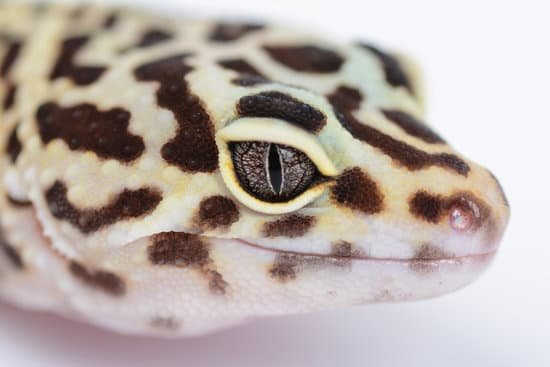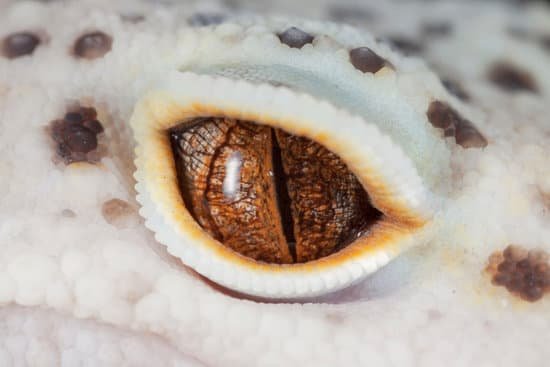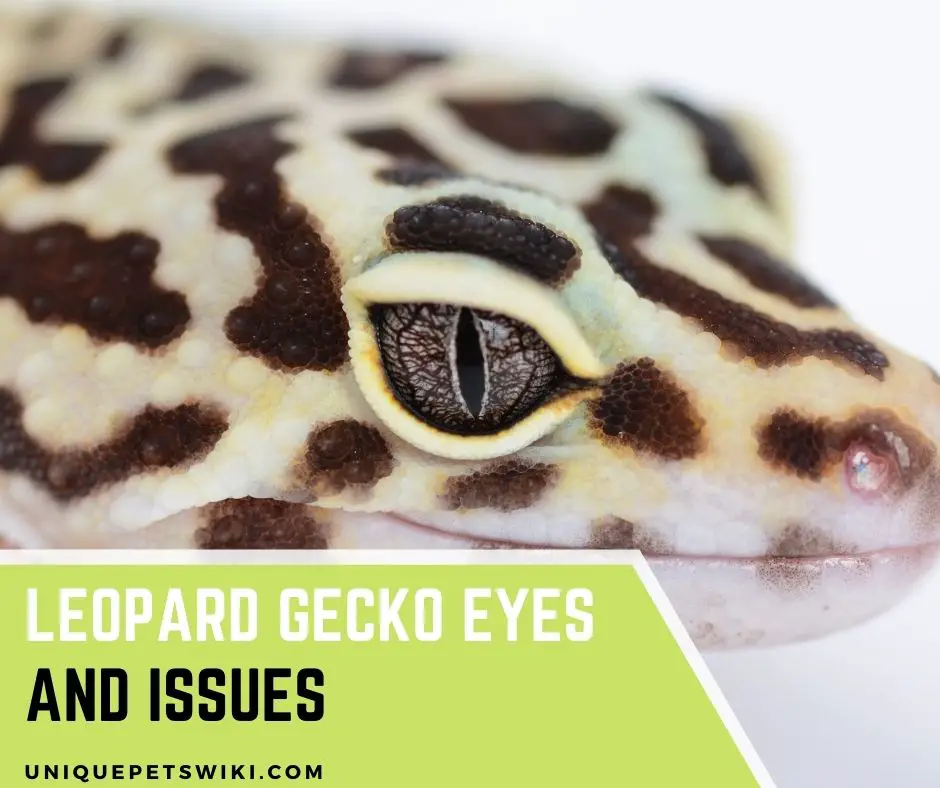One of the most appealing features of a leopard gecko is its large, round, and cute eyes. Unfortunately, they suffer from eye problems due to care and environmental elements.
When you get your favorite leopard gecko pet, you want to enjoy its curious appearance. At times this does not happen when they get eye problems.
You have to recognize the eye problems as they develop adversely. Identifying the problem on time will allow you to offer the appropriate care. You must also know when to contact your exotic vet for assistance.
In this article, we will inform you all about your leopard gecko’s eyes and the problems that they may experience. We will also outline solutions that will help in the eradication of eye problems.
This article has been reviewed by Dr. Gospel. Read more about our knowledge control process here.
Contents
Leopard Gecko Eyes Appearance

Leopard geckos have beautiful and unique eyes, which makes them quite interesting. Unlike most geckos and reptiles, this morph comes with eyelids. The eyelids are movable and translucent.
As such, your leopard gecko is able to blink and close its eyes when it sleeps. Another interesting part of the eye is the pupil. During the day, the pupil appears like a small slit, and it turns into a round shape at night.
The most common eye trait for the leopard geckos includes dark and slightly metallic tinged irises. Since they are nocturnal, they have good night vision.
The slits form during the day due to their high sensitivity to light. If the pupils do not slit, the light rays can lead to serious damages to their vision.
Another common eye trait is solid black, or what is also referred to as eclipse or snake eyes. Such a leopard gecko will have black irises as opposed to the metallic tinged type. It is difficult to identify and differentiate the iris from the pupil due to the black orb appearance.
The ruby eye is another trait present in some leopard geckos. Its appearance has a close resemblance to the solid black eyes. The Blazing Blizzard has the most attractive and striking ruby eyes.
Leopard geckos with albinism possess solid red eyes due to their lack of dark pigment in the iris, which would otherwise obscure the underlying retinal blood vessels.
Note: not all albino leopard geckos will have solid red eyes. The solid red eyes may also appear if the eggs get incubated at around 90oF.
Out of the three kinds of albino leopard geckos; Bell, Rainwater, and Tremper, the Bell leopard gecko has the most prominent shade of red in the eyes. The other two have red eyes at the beginning, but they fade as they grow older.
Eye Issues in Leopard Geckos

While these pets have some of the most appealing and lovely looking eyes, they are highly prone to infections. Unfortunately, this problem is even higher in leopard geckos held in captivity.
You may observe your pet leopard gecko closing one or both eyes more often than usual, it may have discharge around the eye, or it may even seem blind. The eye issues may be simple, common, and easily treatable at home. Other times, they may be serious to a level where an exotic animal vet is required to treat them.
As a leopard gecko owner, breeder, or enthusiast, you must have noted that their eyes are large in proportion to the size of their heads. As cute as this may seem, it is also the main reason why they easily get stuff stuck in the eyes and develop infections and abscesses.
Consequently, leopard geckos have more ocular problems than most of the other animals. Otherwise, the eye problems may also be congenital or arise from some lacking elements of their environment or diet.
Debris or Foreign Bodies
Foreign bodies are items or stuff in your leopard gecko’s eye which should not be there. The range of items that may end up in your gecko’s eyes is vast. It could be gravel, bedding, retained skin, or any other item that would not be in the eye under normal circumstances.
Such occurrences are mainly linked to loose substrates, such as sand. That’s why sand and other loose substrates are discouraged, in addition to causing impaction. Such materials can cause multiple eye problems if no removed with urgency.
It may be possible to flush out some debris out of the eye with saline water or other eyewashes. However, if there is any resulting abrasion or ulceration, you need to seek treatment from a vet.
Abscess
Your leopard gecko’s eye may get punctured or get an infection that results in an abscess. The most common entails the part under the eye swelling due to an abscess due to a wound that does not include the eyeball.
When handling your pet, or just viewing it in its cage, you need to give it a thorough check. Abscesses are easy to identify around the eyes of your pet.
It may present as a small bump with some debris collecting under the eye. Trauma or systemic infection is a common cause of this condition. In such cases, surgery is required for their removal.
Such abscesses may also result from a cricket or mealworm bite, or the pet may have scratched on an object within the tank. It might also result from a fight with another leopard gecko if they are cohabiting.
Some abscess associated with Gram-bacterial isolates may be difficult to manage. Vitamin A deficiency and conjunctivitis may also lead to pseudo abscesses.
If you notice that your leopard gecko has these signs, you have to consult a vet. Treatment mostly consists of lancing and debridement under anesthesia. Antibiotics and pain medications, as well as, nutritional support are prescribed.
Eye Ulcers
An eye ulcer can form after a foreign body gets stuck in the eyeball. It may also result from the eyeball suffering some form of trauma. In this case, your leopard gecko’s cornea (the clear outer coating of the eye) gets damaged.
Therefore, simply put, an ulcer is a hole or a tear in the cornea, and its size may vary from small to extremely large. Ulcers can be very painful for your pet, and you may notice it holding the eye shut at all times. It may also attempt to clean it using the tongue, or scratching the eye using its foot.
Once you notice ulceration on your pet leopard gecko, you have to seek the assistance of a vet. You must do it with urgency to prevent extensive and potentially irreversible damage to the eye.
Pinkeye
Your leopard gecko could also suffer from pinkeye, or what is technically known as conjunctivitis. It appears as an inflammation of the pink tissue that lines the lids of your leo’s eyes.
The pinkish-red part of the eye is known as the conjunctiva, and it is prone to bacterial infection especially in leopard geckos. Such bacteria can easily result from dirty water or any dirt that may be in its environment.
When a leopard gecko has the pinkeye, their eyelids will close and there will be discharge accumulation that will lead to a bulge of the eyelid.
An unclean tank is a major cause of conjunctivitis in leopard geckos, and cleaning up the tank must be the main preventive action. Failure to maintain hygiene, and extended infection of the leopard gecko may result in eye loss.
You should get the assistance of a vet, and also clean and maintain hygiene in the cage. You will most likely get an antibiotic eye drop or ointment.
Eyelid Lining Retention
Your leopard gecko, like some other reptiles, shed regularly. The eyelid of the leopard gecko is lined with a thin skin layer, which sheds with the rest of the skin.
When the shedding time comes and the terrarium conditions are too dry, the eyelid lining may get stuck, and remain that way. The retention will lead to irritation, and if nothing is done soon, it will lead to an infection, and cause eye swelling.
Always check your leopard gecko after shedding to ensure that all the skin has shed, and nothing is retained around the eyes. If your leopard gecko has a problem, it may blink more frequently than not and may rub that area.
If there are retained eyelid liners, you must not attempt to remove them. The problem requires the attention of a veterinary.
As always, prevention is better than cure, and you should have a few preventive measures in place. Always keep the cage at the recommended humidity level at all times.
Shedding problems also emanate from low vitamin A levels, and you need to provide vitamin and mineral supplements to your leopard gecko when feeding. Gut loading and dusting the food is important to prevent such deficiency.
Proptosis
Proptosis is arguably the worst form of eye problem but is also rare among leopard geckos. What this means is that your leopard gecko’s eye protrudes out of its eye socket.
Exophthalmos disease is another name for proptosis. It occurs mainly due to the abnormal extraocular muscles and abnormality in the connection of the tissue deposition.
If left untreated, the eyelids will fail to close and this will cause corneal dryness. It also eliminates the protection that the eye would have, and this also damages it.
In the unfortunate case that it occurs, this would be a literal nightmare for you and your pet leopard gecko. When it happens, you must seek the assistance of a veterinary, and most likely the eye will be surgically removed to save your pet the anguish.
Congenital Eye Defects
Sometimes your leopard gecko is born with an eye abnormality, such as microphthalmia, which results from inbreeding. Other gene-related ailments may include cyclopia and anophthalmos. Congenital deformation of the eyelids may also happen and may result in ulceration or infection.
Fused eyelids at birth may also happen, and this can be resolved via corrective surgery. At times, the leopard gecko is born blind. If it’s born blind and without any other problem, it should not have an issue.
In the case of blindness, you may need to help the blind leopard gecko with feeding as it may have a hard time chasing and catching moving insects. Otherwise, it should live a comfortable and full life.
Leopard Gecko Eyes Turned Black
Some leopard geckos are born with black eyes, and this should remain the same throughout their life. However, a leopard gecko may have its eyes turn from another color to black.
Such a change normally happens in conjunction with another eye problem. The problem should be resolved when you get the main problem treated.
In case the color change does not come together with another ailment, it is advisable for you to seek the advice of an exotic pet veterinarian.
Leopard Gecko One Eye Closed
Occasionally, your pet leopard gecko will close one of its eyes. You may see this happen when it is sleeping, and while you may think that they sleep with one eye open, it is unlikely the case.
When it opens one of the eyes during sleep, it means that there may be some disturbance near them, such as noise or potential predator.
While it should not always happen, opening one eye or having one eye closed might be normal in the highlighted scenarios.
If your pet leopard gecko has one closed eye with discharge or it is swollen, it is a sign of an eye problem. In that case, you need to seek the assistance of a vet.
Can leopard geckos close their eyes?
Unlike many geckos that lack eyelids, your leopard geckos have them. As such, they can close their eyes and also blink.
They should not keep them closed for long unless they are sleeping. You should notice if there is any problem with the eyelids.
How to Prevent Eye Issues For Your Leopard Gecko?
Proactiveness is important to prevent eye problems and keep safe and healthy leopard geckos. A few preventive measures that you should observe include:
- Always maintain a clean and stable environment within the gecko’s enclosure. When handling it, you also need to observe hygiene.
- Ensure that the optimal conditions are maintained in the terrarium, and they include temperature, humidity, and light.
- The water and substrate should also be clean, and this is critical to health and safety.
- Always select the right substrate for your leopard gecko. Certain materials, such as sand, wood chips, gravel, and walnut shells are not ideal for leopard geckos.
- Only include smooth-edged items in your leopard gecko’s enclosure. You should not keep items with sharp edges or points that may poke the gecko’s eyes.
- You can add a humidity hide box in the cage to ensure that it has the right amount of humidity when shedding to prevent retained eyelid linings.
- Feeding should be done properly with the appropriate diet, and appropriate vitamin and mineral supplements.
- Always consult your vet whenever you are unsure about an issue with your pet leopard gecko.
Common FAQs about leopard geckos eyes
Do leopard geckos eyes change color?
Your leopard gecko can change eye color, but this is normal when a young one grows and matures. For instance, young albino leopard geckos tend to have solid-colored eyes when young, and once they mature, their eyes may turn into the normal color range.
Morphs with eclipse eyes are also known to change eye color as they develop and age into a less solid color.
You may also experience a change in the pupil from a slit during the daytime, to a completely solid color at night. This happens due to the nocturnal nature of the leopard geckos.
Otherwise, if there is a color change, and you cannot tell why it is happening, it is always advisable to seek professional guidance from a vet.
What colors Do leopard geckos eyes have?
Leopard geckos have some of the most interesting eyes among the geckos and reptiles at large. Their eye color may range from solid black, dark with slightly metallic-tinged irises, ruby, and red.
Most of them retain their eye colors throughout their lives. Some Albino leopard geckos experience a slight change of eye color as they grow older. Mainly, the color is usually red when young, and it may fade slightly as they get older.
What is a leopard geckos vision like?
Leopard geckos have excellent eyesight, which allows them to hunt with ease at night, and remain hidden from predators in the wild.
The vision of these adorable pets is often compared to that of the cat, and it is significantly better than that of other gecko species.
Some owners feel like their leopard gecko is either blind or they act blind. Naturally, these pets are not blind, but they can develop eyesight problems over time.
Wrapping Up
Leopard geckos are some of the most adorable reptilian pets you can have. Their eyes make up one of the most adorable parts of their bodies. While they look appealing, they are highly prone to eye problems.
You should always check your pet’s eyes on potential problems. Always feed them a proper diet and maintain hygiene and cleanliness in the cage. Humidity should also be kept at the optimum level.
In case you find a problem with the pet, it is advisable to seek professional advice from a vet. We would love to hear your feedback in case you have a question or comment.

My gecko has a swollen eyelid. In the car on the inside is an off-white color what could they possibly be? I will be taking him to the vet to find out more but I was curious. Thank you